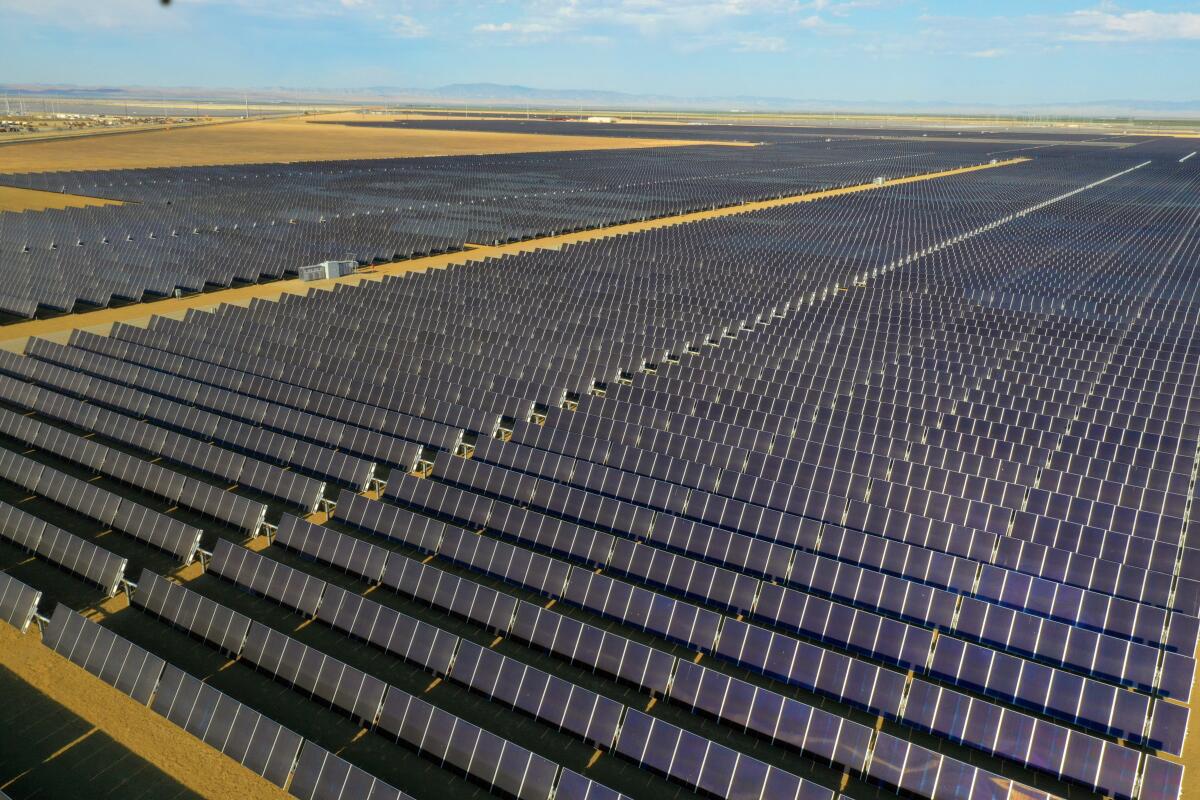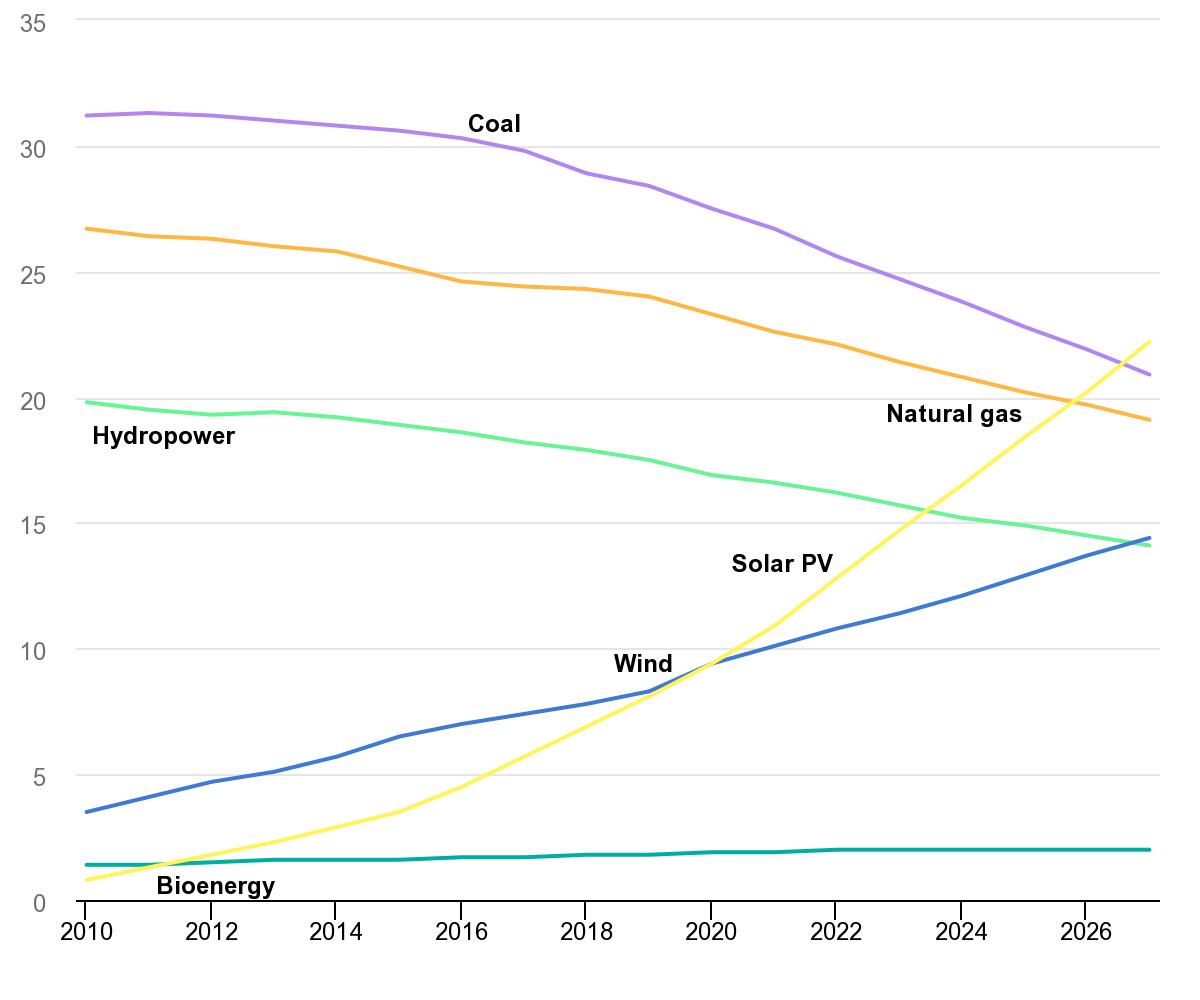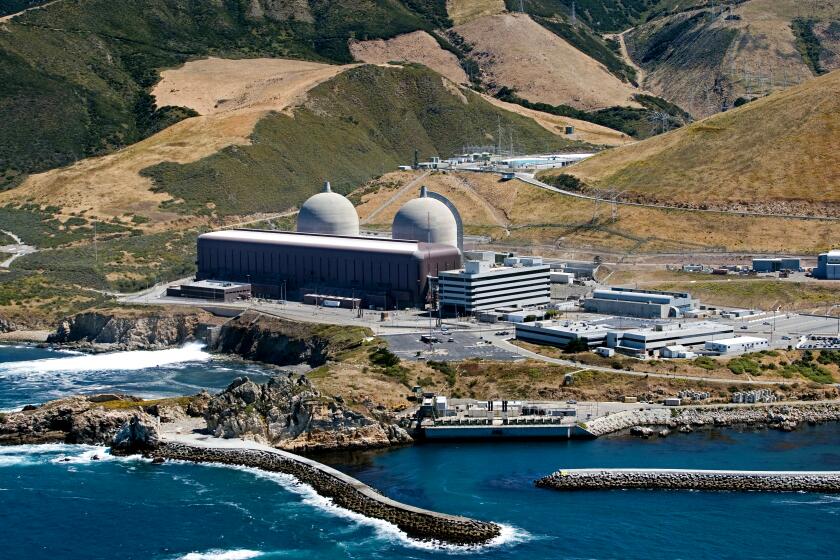Column: Solar and wind energy are killing off fossil fuel, despite the right’s best efforts

American conservatives may be trying to hold back the tide, but solar and wind power are surging worldwide, leaving coal, natural gas and oil in the dust as energy sources.
That’s the conclusion of the International Energy Agency, which says in its latest annual report on renewables, released Dec. 6, that solar and wind power will become the largest source of electricity generation worldwide by 2025.
In its share of total generating capacity, the IEA says, solar alone will outstrip natural gas by 2026 and coal, which has held the top spot for decades, by
2027.
The global energy crisis is pushing the accelerator on renewable energy expansion.
— International Energy Agency
These new estimates are the product of rapidly changing conditions in the U.S. and worldwide. Among them is the energy crisis triggered by Russia’s invasion of Ukraine, which disrupted deliveries of oil and gas from Russia to Europe.
The resulting spike in prices made solar and wind generation more competitive economically and prompted countries around the world to accelerate efforts to wean themselves from fossil fuels.
Get the latest from Michael Hiltzik
Commentary on economics and more from a Pulitzer Prize winner.
You may occasionally receive promotional content from the Los Angeles Times.
Another factor is the emergence of new policy initiatives in China and the U.S., according to the IEA, a Paris-based intergovernmental agency.
China is expected to install “almost half of new global renewable power capacity over 2022-2027,” the IEA says, judging from the goals it set in its latest five-year plan.
The Inflation Reduction Act, signed by President Biden on Aug. 16, provides some $370 billion in support for clean energy projects and greenhouse gas reduction.
Biden’s description of the bill as America’s “most aggressive action ever to combat the climate crisis” has been echoed by green energy advocates.
Blindly protecting investments in coal and oil without taking account of the changing world is a formula for impoverishment — environmentally, socially, and especially financially.
Energy Innovation Policy and Technology, a San Francisco think tank, estimated that the Inflation Reduction Act’s provisions could cut greenhouse gas emissions to 37% to 43% below 2005 levels by 2030, making the measure “the most significant federal climate and clean energy legislation in U.S. history.”
The IEA’s projections are a massive leap from its expectation only a year ago, with a 30% increase in installed renewables capacity over last year’s forecast. The growth of almost 2,400 gigawatts projected for 2022-27 is “equal to the entire installed power capacity of China today,” the IEA says.
These figures underscore the stupidity of campaigns by the American right wing against green investments. As I reported recently, red states are withdrawing millions of dollars in assets from investment firms they accuse of boycotting oil, gas and coal companies and of acknowledging the economic impacts of global warming.
Sooner or later, these states will have to face up to reality: Coal and gas are dying energy sources and renewables are the wave of the future. My colleague Noah Bierman reports that Kentucky will soon be employing twice as many people in electric vehicle jobs as in the coal industry.

That’s not surprising — coal mining employment in that state has fallen from more than 18,600 workers to 4,200 in just the last 10 years. Nevertheless, Kentucky is among the red states that have attacked the institutional money managers BlackRock and Vanguard for considering the worldwide transition from fossil fuels to renewables as an investment factor.
Solar and wind aren’t the only renewable energy sources addressed in the IEA forecast.
Also mentioned is hydropower, though the agency says that environmental permitting and construction obstacles will slow that source’s growth; indeed, the IEA expects hydro to fall from 16.2% of worldwide power capacity today to 14.1% in 2027, largely because it will be outrun by solar and wind.
By 2027, the IEA forecasts, solar, wind and hydropower will account for 50.7% of global generating capacity, while coal and gas will fall to 40%. Nuclear, which by some measures counts as “green” energy because it does not produce greenhouse gases, will remain stable but declining at 9.4%, down from about 9.9% today.
Geothermal will remain a marginal source because of its high investment costs. Hydrogen is a promising renewable fuel, the IEA says, but its most significant role would be to spur the growth of solar and wind, since producing hydrogen for fuel requires energy.
One energy source entirely unmentioned in the IEA forecast is fusion. The nuclear process that powers the sun has long been a holy grail for Earth-bound researchers, but no one has been able to report success at staging fusion reactions that reliably produce net gains in energy without climate effects — until now.
The U.S. Department of Energy is reportedly poised to announce on Tuesday a “breakthrough” in fusion research at the agency’s Lawrence Livermore National Laboratory. The details of the achievement are still unclear, though it’s likely that many years of further development will be necessary before it’s a meaningful contributor to the grid.
Gov. Newsom says Diablo Canyon needs to keep operating to meet California’s renewable energy goals. That’s wrong and dangerous.
In the meantime, solar and wind power are the sources that will transform the global energy landscape, bringing the world closer to the goal of net-zero emissions by 2050. According to the IEA forecast, the dominant player in that transformation will be China.
The Inflation Reduction Act is likely to reverse years of inaction by the U.S. government on climate goals, a welcome counterweight to China’s position in energy technologies.
“There is a strong competition between the largest economies of the world to have a pole position when it comes to the next chapter of the industry sector,” IEA Executive Director Fatih Birol told the Financial Times. The U.S. and India are stepping up manufacturing of solar photovoltaic equipment, in part to cut their reliance on Chinese manufacturers.
What the IEA forecast makes clear is that renewable energy has outpaced expectations from only a few years ago, and may continue to grow exponentially as long as government policies evolve to support it.
Even if the effect of Russia’s invasion of Ukraine were to vanish tomorrow, it has awakened decision makers across the developed world to the necessity of moving away from fossil fuels as a matter of national security.
“The global energy crisis,” the IEA concluded, “is pushing the accelerator on renewable energy expansion.”
More to Read
Get the latest from Michael Hiltzik
Commentary on economics and more from a Pulitzer Prize winner.
You may occasionally receive promotional content from the Los Angeles Times.













